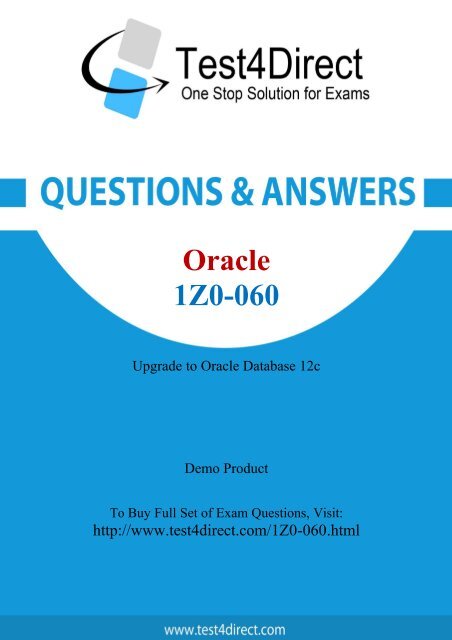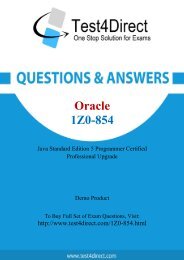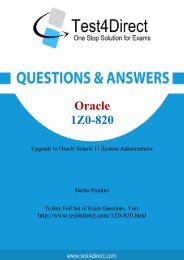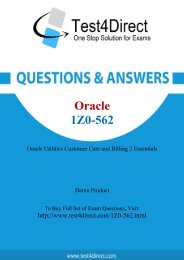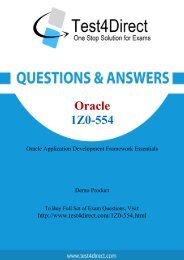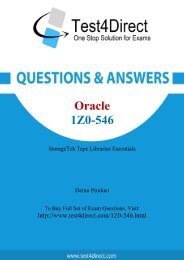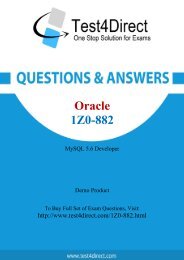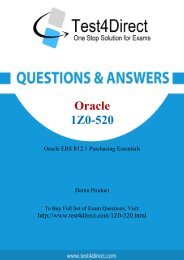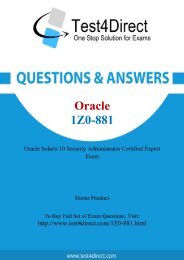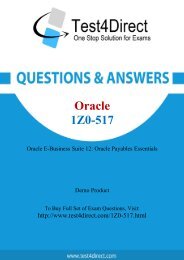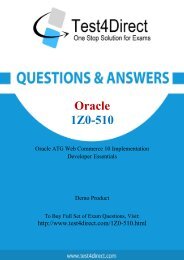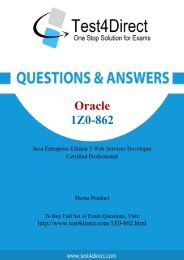1Z0-060 Real BrainDumps
Test4Direct provides latest PDF questions of Oracle 1Z0-060 exam. You have an opportunity to pass the Oracle 1Z0-060 exam in one go. Test4Direct is most accurate source to prepare Oracle 1Z0-060 exam as your success will become site’s responsibility after purchasing 1Z0-060 exam product. There are also lots of discounts and promotion offers that you can avail. Let’s try a free demo http://www.test4direct.com/1Z0-060.html
Test4Direct provides latest PDF questions of Oracle 1Z0-060 exam. You have an opportunity to pass the Oracle 1Z0-060 exam in one go. Test4Direct is most accurate source to prepare Oracle 1Z0-060 exam as your success will become site’s responsibility after purchasing 1Z0-060 exam product. There are also lots of discounts and promotion offers that you can avail. Let’s try a free demo http://www.test4direct.com/1Z0-060.html
You also want an ePaper? Increase the reach of your titles
YUMPU automatically turns print PDFs into web optimized ePapers that Google loves.
Oracle<br />
<strong>1Z0</strong>-<strong>060</strong><br />
Upgrade to Oracle Database 12c<br />
Demo Product<br />
To Buy Full Set of Exam Questions, Visit:<br />
http://www.test4direct.com/<strong>1Z0</strong>-<strong>060</strong>.html
Question: 1<br />
Your multitenant container (CDB) contains two pluggable databases (PDB), HR_PDB and<br />
ACCOUNTS_PDB, both of which use the CDB tablespace. The temp file is called temp01.tmp.<br />
A user issues a query on a table on one of the PDBs and receives the following error:<br />
ERROR at line 1:<br />
ORA-01565: error in identifying file ‘/u01/app/oracle/oradata/CDB1/temp01.tmp’<br />
ORA-27037: unable to obtain file status<br />
Identify two ways to rectify the error.<br />
A. Add a new temp file to the temporary tablespace and drop the temp file that that produced the<br />
error.<br />
B. Shut down the database instance, restore the temp01.tmp file from the backup, and then restart<br />
the database.<br />
C. Take the temporary tablespace offline, recover the missing temp file by applying redo logs, and<br />
then bring the temporary tablespace online.<br />
D. Shutdown the database instance, restore and recover the temp file from the backup, and then<br />
open the database with RESETLOGS.<br />
E. Shut down the database instance and then restart the CDB and PDBs.<br />
Question: 2<br />
Answer: CE<br />
Explanation:<br />
* Because temp files cannot be backed up and because no redo is ever generated for them, RMAN<br />
never restores or recovers temp files. RMAN does track the names of temp files, but only so that it<br />
can automatically re-create them when needed.<br />
* If you use RMAN in a Data Guard environment, then RMAN transparently converts primary control<br />
files to standby control files and vice versa. RMAN automatically updates file names for data files,<br />
online redo logs, standby redo logs, and temp files when you issue RESTORE and RECOVER.<br />
Examine the following commands for redefining a table with Virtual Private Database (VPD) policies:
Which two statements are true about redefining the table?<br />
A. All the triggers for the table are disabled without changing any of the column names or column<br />
types in the table.<br />
B. The primary key constraint on the EMPLOYEES table is disabled during redefinition.<br />
C. VPD policies are copied from the original table to the new table during online redefinition.<br />
D. You must copy the VPD policies manually from the original table to the new table during online<br />
redefinition.<br />
Question: 3<br />
Answer: BC<br />
Explanation:<br />
C (not D): CONS_VPD_AUTO<br />
Used to indicate to copy VPD policies automatically<br />
* DBMS_RLS.ADD_POLICY<br />
/ The DBMS_RLS package contains the fine-grained access control administrative interface, which is<br />
used to implement Virtual Private Database (VPD).DBMS_RLS is available with the Enterprise Edition<br />
only.<br />
Note:<br />
* CONS_USE_PK and CONS_USE_ROWID are constants used as input to the "options_flag" parameter<br />
in both the START_REDEF_TABLE Procedure and CAN_REDEF_TABLE Procedure. CONS_USE_ROWID is<br />
used to indicate that the redefinition should be done using rowids while CONS_USE_PK implies that<br />
the redefinition should be done using primary keys or pseudo-primary keys (which are unique keys<br />
with all component columns having NOT NULL constraints).<br />
* DBMS_REDEFINITION.START_REDEF_TABLE<br />
To achieve online redefinition, incrementally maintainable local materialized views are used. These<br />
logs keep track of the changes to the master tables and are used by the materialized views during<br />
refresh synchronization.<br />
* START_REDEF_TABLE Procedure<br />
Prior to calling this procedure, you must manually create an empty interim table (in the same<br />
schema as the table to be redefined) with the desired attributes of the post-redefinition table, and<br />
then call this procedure to initiate the redefinition.<br />
Which two statements are true about the use of the procedures listed in the<br />
v$sysaux_occupants.move_procedure column?<br />
A. The procedure may be used for some components to relocate component data to the SYSAUX<br />
tablespace from its current tablespace.<br />
B. The procedure may be used for some components to relocate component data from the SYSAUX<br />
tablespace to another tablespace.<br />
C. All the components may be moved into SYSAUX tablespace.<br />
D. All the components may be moved from the SYSAUX tablespace.<br />
Explanation:<br />
V$SYSAUX_OCCUPANTS displays SYSAUX tablespace occupant information.<br />
MOVE_PROCEDURE: Name of the move procedure; null if not applicable<br />
Answer: BD
For example, the tables and indexes that were previously owned by the system user can now be<br />
specified for a SYSAUX tablespace. You can query the v$sysaux_occupants view to find the exact<br />
components stored within the SYSAUX tablespace.<br />
Question: 4<br />
Which statement is true about Oracle Net Listener?<br />
A. It acts as the listening endpoint for the Oracle database instance for all local and non-local user<br />
connections.<br />
B. A single listener can service only one database instance and multiple remote client connections.<br />
C. Service registration with the listener is performed by the process monitor (PMON) process of each<br />
database instance.<br />
D. The listener.ora configuration file must be configured with one or more listening protocol<br />
addresses to allow remote users to connect to a database instance.<br />
E. The listener.ora configuration file must be located in the ORACLE_HOME/network/admin directly.<br />
Question: 5<br />
Answer: C<br />
Explanation:<br />
Supported services, that is, the services to which the listener forwards client requests, can be<br />
configured in the listener.ora file or this information can be dynamically registered with the listener.<br />
This dynamic registration feature is called service registration. The registration is performed by the<br />
PMON process—an instance background process—of each database instance that has the necessary<br />
configuration in the database initialization parameter file. Dynamic service registration does not<br />
require any configuration in the listener.ora file.<br />
Incorrect:<br />
Not B: Service registration reduces the need for the SID_LIST_listener_name parameter setting,<br />
which specifies information about the databases served by the listener, in the listener.ora file.<br />
Note:<br />
* Oracle Net Listener is a separate process that runs on the database server computer. It receives<br />
incoming client connection requests and manages the traffic of these requests to the database<br />
server.<br />
* A remote listener is a listener residing on one computer that redirects connections to a database<br />
instance on another computer. Remote listeners are typically used in an Oracle <strong>Real</strong> Application<br />
Clusters (Oracle RAC) environment. You can configure registration to remote listeners, such as in the<br />
case of Oracle RAC, for dedicated server or shared server environments.<br />
You are administering a database stored in Automatic Storage Management (ASM). You use RMAN to<br />
back up the database and the MD_BACKUP command to back up the ASM metadata regularly. You<br />
lost an ASM disk group DG1 due to hardware failure. In which three ways can you re-create the lost<br />
disk group and restore the data?<br />
A. Use the MD_RESTORE command to restore metadata for an existing disk group by passing the<br />
existing disk group name as an input parameter and use RMAN to restore the data.<br />
B. Use the MKDG command to restore the disk group with the same configuration as the backed-up<br />
disk group and data on the disk group.<br />
C. Use the MD_RESTORE command to restore the disk group with the changed disk group
specification, failure group specification, name, and other attributes and use RMAN to restore the<br />
data.<br />
D. Use the MKDG command to restore the disk group with the same configuration as the backed-up<br />
disk group name and same set of disks and failure group configuration, and use RMAN to restore the<br />
data.<br />
E. Use the MD_RESTORE command to restore both the metadata and data for the failed disk group.<br />
F. Use the MKDG command to add a new disk group DG1 with the same or different specifications for<br />
failure group and other attributes and use RMAN to restore the data.<br />
Question: 6<br />
Answer: CEF<br />
Explanation:<br />
Note:<br />
* The md_restore command allows you to restore a disk group from the metadata created by<br />
the md_backup command.<br />
/md_restore Command<br />
Purpose<br />
This command restores a disk group backup using various options that are described in this section.<br />
/ In the restore mode md_restore, it re-create the disk group based on the backup file with all userdefined<br />
templates with the exact configuration as the backuped disk group. There are several options<br />
when restore the disk group<br />
full - re-create the disk group with the exact configuration<br />
nodg - Restores metadata in an existing disk group provided as an input parameter<br />
newdg - Change the configuration like failure group, disk group name, etc..<br />
* The MD_BACKUP command creates a backup file containing metadata for one or more disk groups.<br />
By default all the mounted disk groups are included in the backup file which is saved in the current<br />
working directory. If the name of the backup file is not specified, ASM names the file<br />
AMBR_BACKUP_INTERMEDIATE_FILE.<br />
Your multitenant container database, CDB1, is running in ARCHIVELOG mode and has two pluggable<br />
databases, HR_PDB and ACCOUNTS_PDB. An RMAN backup exists for the database. You issue the<br />
command to open ACCOUNTS_PDB and find that the USERDATA.DBF data file for the default<br />
permanent tablespace USERDATA belonging to ACCOUNTS_PDB is corrupted.<br />
What should you do before executing the commands to restore and recover the data file in<br />
ACCOUNTS_PDB?<br />
A. Place CDB1 in the mount stage and then the USERDATA tablespace offline in ACCOUNTS_PDB.<br />
B. Place CDB1 in the mount stage and issue the ALTER PLUGGABLE DATABASE accounts_pdb CLOSE<br />
IMMEDIATE command.<br />
C. Issue the ALTER PLUGGABLE DATABASE accounts_pdb RESTRICTED command.<br />
D. Take the USERDATA tablespace offline in ACCOUNTS_PDB.<br />
Answer: D<br />
Explanation:<br />
* You can take an online tablespace offline so that it is temporarily unavailable for general use. The<br />
rest of the database remains open and available for users to access data. Conversely, you can bring<br />
an offline tablespace online to make the schema objects within the tablespace available to database
users. The database must be open to alter the availability of a tablespace.<br />
Question: 7<br />
Which Oracle Database component is audited by default if the unified Auditing option is enabled?<br />
A. Oracle Data Pump<br />
B. Oracle Recovery Manager (RMAN)<br />
C. Oracle Label Security<br />
D. Oracle Database Vault<br />
E. Oracle <strong>Real</strong> Application Security<br />
Question: 8<br />
Answer: E<br />
Explanation:<br />
Type of Unified auditing:<br />
Standard<br />
Fine Grained Audit<br />
XS<br />
Database Vault (not D)<br />
Label Security (not C)<br />
RMAN AUDIT (not B)<br />
Data Pump (not A)<br />
Note:<br />
* Oracle 12c introduces Unified Auditing, which consolidates database audit records including :-<br />
DDL, DML, DCL<br />
Fine Grained Auditing (DBMS_FGA)<br />
Oracle Database <strong>Real</strong> Application Security<br />
Oracle Recovery Manager<br />
Oracle Database Vault<br />
Oracle Label Security<br />
Oracle Data Mining<br />
Oracle Data Pump<br />
Oracle SQL*Loader Direct Load<br />
Your multitenant container (CDB) containing three pluggable databases (PDBs) is running in<br />
ARCHIVELOG mode. You find that the SYSAUX tablespace is corrupted in the root container. The steps<br />
to recover the tablespace are as follows:<br />
1. Mount the CDB.<br />
2. Close all the PDBs.<br />
3. Open the database.<br />
4. Apply the archive redo logs.<br />
5. Restore the data file.<br />
6. Take the SYSAUX tablespace offline.<br />
7. Place the SYSAUX tablespace offline.<br />
8. Open all the PDBs with RESETLOGS.<br />
9. Open the database with RESETLOGS.<br />
10. Execute the command SHUTDOWN ABORT.
Which option identifies the correct sequence to recover the SYSAUX tablespace?<br />
A. 6, 5, 4, 7<br />
B. 10, 1, 2, 5, 8<br />
C. 10, 1, 2, 5, 4, 9, 8<br />
D. 10, 1, 5, 8, 10<br />
Question: 9<br />
Answer: C<br />
Explanation:<br />
* Example:<br />
While evaluating the 12c beta3 I was not able to do the recover while testing “all pdb files lost”.<br />
Cannot close the pdb as the system datafile was missing…<br />
So only option to recover was:<br />
Shutdown cdb (10)<br />
startup mount; (1)<br />
restore pluggable database<br />
recover pluggable databsae<br />
alter database open;<br />
alter pluggable database name open;<br />
Oracle support says: You should be able to close the pdb and restore/recover the system tablespace<br />
of PDB.<br />
* Open the database with the RESETLOGS option after finishing recovery:<br />
SQL> ALTER DATABASE OPEN RESETLOGS;<br />
Which three are direct benefits of the multiprocess, multithreaded architecture of Oracle Database<br />
12c when it is enabled?<br />
A. Reduced logical I/O<br />
B. Reduced virtual memory utilization<br />
C. Improved parallel Execution performance<br />
D. Improved Serial Execution performance<br />
E. Reduced physical I/O<br />
F. Reduced CPU utilization<br />
Answer: C<br />
Explanation:<br />
* Multiprocess and Multithreaded Oracle Database Systems<br />
Multiprocess Oracle Database (also called multiuser Oracle Database) uses several processes to run<br />
different parts of the Oracle Database code and additional Oracle processes for the users—either one<br />
process for each connected user or one or more processes shared by multiple users. Most databases<br />
are multiuser because a primary advantage of a database is managing data needed by multiple users<br />
simultaneously.<br />
Each process in a database instance performs a specific job. By dividing the work of the database and<br />
applications into several processes, multiple users and applications can connect to an instance<br />
simultaneously while the system gives good performance.<br />
* In previous releases, Oracle processes did not run as threads on UNIX and Linux systems. Starting in
Oracle Database 12c, the multithreaded Oracle Database model enables Oracle processes to execute<br />
as operating system threads in separate address spaces.<br />
Question: 10<br />
In order to exploit some new storage tiers that have been provisioned by a storage administrator, the<br />
partitions of a large heap table must be moved to other tablespaces in your Oracle 12c database?<br />
Both local and global partitioned B-tree Indexes are defined on the table.<br />
A high volume of transactions access the table during the day and a medium volume of transactions<br />
access it at night and during weekends.<br />
Minimal disrupt ion to availability is required.<br />
Which three statements are true about this requirement?<br />
A. The partitions can be moved online to new tablespaces.<br />
B. Global indexes must be rebuilt manually after moving the partitions.<br />
C. The partitions can be compressed in the same tablespaces.<br />
D. The partitions can be compressed in the new tablespaces.<br />
E. Local indexes must be rebuilt manually after moving the partitions.<br />
Explanation:<br />
A: You can create and rebuild indexes online. Therefore, you can update base tables at<br />
the same time you are building or rebuilding indexes on that table. You can perform<br />
DML operations while the index build is taking place, but DDL operations are not<br />
allowed. Parallel execution is not supported when creating or rebuilding an index<br />
online.<br />
B:<br />
Note:<br />
* Transporting and Attaching Partitions for Data Warehousing Typical enterprise data<br />
warehouses contain one or more large fact tables. These fact tables can be partitioned<br />
by date, making the enterprise data warehouse a historical database. You can build<br />
indexes to speed up star queries. Oracle recommends that you build local indexes for<br />
such historically partitioned tables to avoid rebuilding global indexes every time you<br />
drop the oldest partition from the historical database.<br />
D: Moving (Rebuilding) Index-Organized Tables<br />
Because index-organized tables are primarily stored in a B-tree index, you can<br />
encounter fragmentation as a consequence of incremental updates. However, you can<br />
use the ALTER TABLE...MOVE statement to rebuild the index and reduce this<br />
fragmentation.<br />
Question: 11<br />
Answer: ABD<br />
Which three are true about the large pool for an Oracle database instance that supports shared<br />
server connections?<br />
A. Allocates memory for RMAN backup and restore operations<br />
B. Allocates memory for shared and private SQL areas<br />
C. Contains a cursor area for storing runtime information about cursors<br />
D. Contains stack space
E. Contains a hash area performing hash joins of tables<br />
Question: 12<br />
Answer: ABC<br />
Explanation:<br />
The large pool can provide large memory allocations for the following:<br />
/ (B)UGA (User Global Area) for the shared server and the Oracle XA interface (used where<br />
transactions interact with multiple databases)<br />
/Message buffers used in the parallel execution of statements<br />
/ (A) Buffers for Recovery Manager (RMAN) I/O slaves<br />
Note:<br />
* large pool<br />
Optional area in the SGA that provides large memory allocations for backup and restore operations,<br />
I/O server processes, and session memory for the shared server and Oracle XA.<br />
* Oracle XA<br />
An external interface that allows global transactions to be coordinated by a transaction manager<br />
other than Oracle Database.<br />
* UGA<br />
User global area. Session memory that stores session variables, such as logon information, and can<br />
also contain the OLAP pool.<br />
* Configuring the Large Pool<br />
Unlike the shared pool, the large pool does not have an LRU list (not D). Oracle Database does not<br />
attempt to age objects out of the large pool. Consider configuring a large pool if the database<br />
instance uses any of the following Oracle Database features:<br />
* Shared server<br />
In a shared server architecture, the session memory for each client process is included in the shared<br />
pool.<br />
* Parallel query<br />
Parallel query uses shared pool memory to cache parallel execution message buffers.<br />
* Recovery Manager<br />
Recovery Manager (RMAN) uses the shared pool to cache I/O buffers during backup and restore<br />
operations. For I/O server processes, backup, and restore operations, Oracle Database allocates<br />
buffers that are a few hundred kilobytes in size.<br />
What are three purposes of the RMAN “FROM” clause?<br />
A. to support PUSH-based active database duplication<br />
B. to support synchronization of a standby database with the primary database in a Data<br />
environment<br />
C. To support PULL-based active database duplication<br />
D. To support file restores over the network in a Data Guard environment<br />
E. To support file recovery over the network in a Data Guard environment<br />
Answer: BCE<br />
Explanation:<br />
E:<br />
* With a control file autobackup, RMAN can recover the database even if the current control file,
ecovery catalog, and server parameter file are inaccessible.<br />
* RMAN uses a recovery catalog to track filenames for all database files in a Data Guard environment.<br />
A recovery catalog is a database schema used by RMAN to store metadata about one or more Oracle<br />
databases. The catalog also records where the online redo logs, standby redo logs, tempfiles,<br />
archived redo logs, backup sets, and image copies are created.<br />
Question: 13<br />
You notice that the performance of your production 24/7 Oracle database significantly degraded.<br />
Sometimes you are not able to connect to the instance because it hangs. You do not want to restart<br />
the database instance. How can you detect the cause of the degraded performance?<br />
A. Enable Memory Access Mode, which reads performance data from SGA.<br />
B. Use emergency monitoring to fetch data directly from SGA analysis.<br />
C. Run Automatic Database Diagnostic Monitor (ADDM) to fetch information from the latest<br />
Automatic Workload Repository (AWR) snapshots.<br />
D. Use Active Session History (ASH) data and hang analysis in regular performance monitoring.<br />
E. Run ADDM in diagnostic mode.<br />
Question: 14<br />
Answer: C<br />
Explanation:<br />
* In most cases, ADDM output should be the first place that a DBA looks when notified of a<br />
performance problem.<br />
* Performance degradation of the database occurs when your database was performing optimally in<br />
the past, such as 6 months ago, but has gradually degraded to a point where it becomes noticeable<br />
to the users. The Automatic Workload Repository (AWR) Compare Periods report enables you to<br />
compare database performance between two periods of time.<br />
While an AWR report shows AWR data between two snapshots (or two points in time), the AWR<br />
Compare Periods report shows the difference between two periods (or two AWR reports with a total<br />
of four snapshots). Using the AWR Compare Periods report helps you to identify detailed<br />
performance attributes and configuration settings that differ between two time periods.<br />
Reference: Resolving Performance Degradation Over Time<br />
You plan to use the In Database Archiving feature of Oracle Database 12c, and store rows that are<br />
inactive for over three months, in Hybrid Columnar Compressed (HCC) format. Which three storage<br />
options support the use of HCC?<br />
A. ASM disk groups with ASM disks consisting of Exadata Grid Disks.<br />
B. ASM disk groups with ASM disks consisting of LUNS on any Storage Area Network array<br />
C. ASM disk groups with ASM disks consisting of any zero padded NFS-mounted files<br />
D. Database files stored in ZFS and accessed using conventional NFS mounts.<br />
E. Database files stored in ZFS and accessed using the Oracle Direct NFS feature<br />
F. Database files stored in any file system and accessed using the Oracle Direct NFS feature<br />
G. ASM disk groups with ASM disks consisting of LUNs on Pillar Axiom Storage arrays<br />
Answer: AEG
Explanation:<br />
HCC requires the use of Oracle Storage – Exadata (A), Pillar Axiom (G) or Sun ZFS Storage Appliance<br />
(ZFSSA).<br />
Note:<br />
* Hybrid Columnar Compression, initially only available on Exadata, has been extended to support<br />
Pillar Axiom and Sun ZFS Storage Appliance (ZFSSA) storage when used with Oracle Database<br />
Enterprise Edition 11.2.0.3 and above<br />
* Oracle offers the ability to manage NFS using a feature called Oracle Direct NFS (dNFS). Oracle<br />
Direct NFS implements NFS V3 protocol within the Oracle database kernel itself. Oracle Direct NFS<br />
client overcomes many of the challenges associated with using NFS with the Oracle Database with<br />
simple configuration, better performance than traditional NFS clients, and offers consistent<br />
configuration across platforms.<br />
Question: 15<br />
In your multitenant container database (CDB) containing pluggable databases (PDB), users complain<br />
about performance degradation.<br />
How does real-time Automatic database Diagnostic Monitor (ADDM) check performance degradation<br />
and provide solutions?<br />
A. It collects data from SGA and compares it with a preserved snapshot.<br />
B. It collects data from SGA, analyzes it, and provides a report.<br />
C. It collects data from SGA and compares it with the latest snapshot.<br />
D. It collects data from both SGA and PGA, analyzes it, and provides a report.<br />
Answer: B<br />
Explanation:<br />
Note:<br />
* The multitenant architecture enables an Oracle database to function as a multitenant container<br />
database (CDB) that includes zero, one, or many customer-created pluggable databases (PDBs). A<br />
PDB is a portable collection of schemas, schema objects, and nonschema objects that appears to an<br />
Oracle Net client as a non-CDB. All Oracle databases before Oracle Database 12c were non-CDBs.<br />
* The System Global Area (SGA) is a group of shared memory areas that are dedicated to an Oracle<br />
“instance” (an instance is your database programs and RAM).<br />
* The PGA (Program or Process Global Area) is a memory area (RAM) that stores data and control<br />
information for a single process.
THANKS FOR TRYING THE DEMO OF OUR PRODUCT<br />
Visit Our Site to Purchase the Full Set of Actual <strong>1Z0</strong>-<strong>060</strong> Exam Questions With Answers.<br />
http://www.test4direct.com/<strong>1Z0</strong>-<strong>060</strong>.html<br />
We Also Provide Practice Exam Software That Simulates <strong>Real</strong> Exam Environment And Has<br />
Many Self-Assessment Features. Download Free Product Demo From:<br />
http://www.test4direct.com/<strong>1Z0</strong>-<strong>060</strong>.html<br />
Money Back Guarantee<br />
Check Out Our Customer Testimonials


